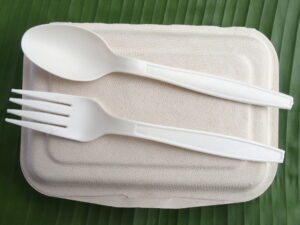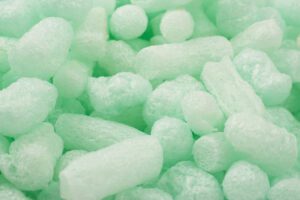
You’ve probably been taught to throw your plastics in the recycling bin. The reasoning is that plastics, by virtue of being synthetic, can’t break down into their component parts. If one was to end up in a landfill, it would sit there for all eternity. This is why they’re recycled, so they can be broken down artificially and reused for new products.
Bioplastics, however, are able to break down, given enough time. They’re made using natural materials, with corn starch being among the most common. They can be almost impossible to differentiate from regular plastics and some can even be composted.
The process behind the production of bioplastics varies (depending on what materials are used). When using polylactide acid (PLA), for example, it starts with an absurd number of corn kernels. The kernels are processed and milled until the dextrose is extracted. The dextrose is then fermented until it becomes lactic acid, which is later converted to lactide at a chemical plant. Lastly, the lactide is polymerized, and the resulting PLA is used to create bioplastics.
PLA bioplastics use 2/3 less power than is required to make traditional plastics, but there are still plenty of drawbacks. For one, the cornstarch used in many bioplastics could be used as a food source instead of for takeout containers. PLA can’t be recycled alongside traditional PET (polyethylene terephthalate) plastics, despite the two looking almost identical. And as previously stated, not all bioplastics will break down.
Biodegradable plastics, a type of bioplastic, can decay more rapidly than their traditional counterparts. But they’re not without their flaws. Many types of biodegradable plastics leave behind a toxic residue making them unsuitable for composting. If thrown into the ocean, they either fail to break down or leave behind plastic particles dangerous to sea life.
If plastic is recycled, it is often reused to create new plastic items. These recycled plastics are becoming increasingly common- many shopping bags or milk bottles proudly proclaim being made from recycled materials. The two fundamental issues from recycled plastics are the process of recycling itself and where the plastics end up. Collecting and recycling plastics uses a great deal of energy, sometimes more than what would be required to make new plastics in the first place. Furthermore, recycling a pop bottle doesn’t turn it into another pop bottle. It could become a bench or fence post or some other lower-quality product.
The underlying problem with bioplastics is the reliance humans have on plastics to begin with. Everything from our containers to our clothes has plastic in it. And the dangers of plastics on our environment are well-documented; most people know they produce methane gas and endanger wildlife. It’s better to avoid all types of plastics and use longer-lasting alternatives.
But the bioplastics industry is booming, and hopefully, this financial success will help fund additional research to make them better for the environment. Three high schoolers (one from Sydney and two from Giza) have unveiled their ideas for bioplastics, using shrimp shells or banana peels as bases, respectively. The shrimp plastics, in particular, are about as durable as traditional petroleum-based alternatives. They also dissolve in a scant five weeks, making them decidedly biodegradable. Other studies are being conducted to see if soybeans could be used to create bioplastics, although applications are limited at this time.

Humans depend on plastics, whether we want to or not. And it would be almost impossible for us to stop using them because of how prevalent they are in society. Bioplastics, however, are working to lessen the impact plastics have on the rest of the planet, even if they have their own set of risks and rewards. One day, though, the benefits may far outweigh the negatives.
Until then, though, keep recycling, and make sure you separate your PETs and your PLAs.
Follow our World of Production on Instagram–where big ideas bring big growth.




